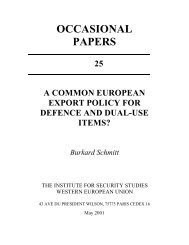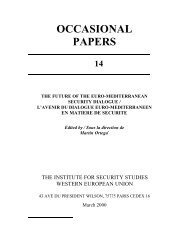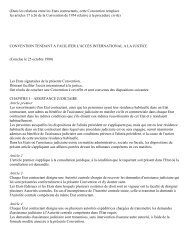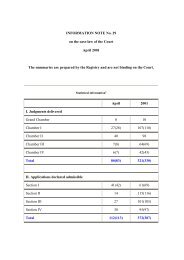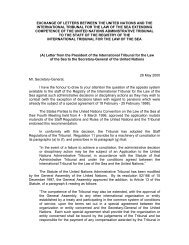Party Autonomy in International Property Law - Peace Palace Library
Party Autonomy in International Property Law - Peace Palace Library
Party Autonomy in International Property Law - Peace Palace Library
You also want an ePaper? Increase the reach of your titles
YUMPU automatically turns print PDFs into web optimized ePapers that Google loves.
D. Assignment; F<strong>in</strong>ancial Instruments; Insolvency <strong>Law</strong><br />
issues together <strong>in</strong> either one of them. As yet, there is no property Regulation.<br />
Thus, the place for third-party effectiveness is only <strong>in</strong> Rome I. We<br />
have no other place at present and for the foreseeable future.<br />
F<strong>in</strong>ally, one needs to consider how Article 14 – if deprived of application<br />
to third-party effectiveness – would fit <strong>in</strong> with the European Treaties.<br />
The Preamble <strong>in</strong> Recital 43 expressly claims Rome I to accord with the<br />
pr<strong>in</strong>ciple of subsidiarity, laid down <strong>in</strong> Article 5 of the Union Treaty (formerly<br />
Article 5 of the Community Treaty), because the legislative aim, it<br />
says, could be better achieved at the Community level than at the level<br />
of Member States. The overall legislative aim is, and must be, to build<br />
up and equip with rules on conflict of laws the European Area of Justice;<br />
the Regulation is expressly based on former Article 65 of the Community<br />
Treaty, now Article 81 of the Treaty on EU Function<strong>in</strong>g. However, not to<br />
<strong>in</strong>clude the property effects with regard to third parties <strong>in</strong> Rome I would,<br />
under present conditions, mean leav<strong>in</strong>g this issue to the legislative competence<br />
of the Member States. 30 As a consequence, it could no longer be<br />
submitted to the European Court of Justice. The issue has been termed by<br />
all the experts as one of utmost importance and <strong>in</strong>tricacy. To exclude it<br />
from Rome I would therefore run counter to the very constitutional idea<br />
on which Rome I was based by the legislator.<br />
10.3.4. Purpose<br />
The overall objective of rules on conflict of laws is to provide certa<strong>in</strong>ty<br />
by designat<strong>in</strong>g the applicable law where an abundance of compet<strong>in</strong>g and<br />
possibly applicable laws produces <strong>in</strong>security. In the European Union, this<br />
central idea takes on a special flavour. The Union is set up to be an area<br />
of freedom, security, and justice, and an <strong>in</strong>ternal market ‘without <strong>in</strong>ternal<br />
borders’, 31 although it is not able, constitutionally and politically, to provide<br />
unity of substantive law. Union-wide unified rules on the <strong>in</strong>evitable<br />
conflict of laws are eagerly sought as a way out of this dilemma, and they<br />
30<br />
There is agreement on this result among most authors, although not whether<br />
the result is, or would be, welcome; Flessner (note 6) 38, 39; Sigman / Kien<strong>in</strong>ger<br />
(note 5) 54, 55; Garcimartín Alférez (note 5) 235; Bauer (note 5) 301; Plender / <br />
Wildersp<strong>in</strong> (note 4) 379; Mart<strong>in</strong>y (note 4) Article 14 nr. 16; Verhagen / van<br />
Dongen (note 2) 12; van der Gr<strong>in</strong>ten (note 24).<br />
31<br />
Article 3 (formerly Article 2) of the Union Treaty; Article 26 of the Treaty on<br />
the Function<strong>in</strong>g of the EU (formerly Article 14 of the Community Treaty).<br />
218<br />
Axel Flessner<br />
© sellier. european law publishers<br />
www.sellier.de



